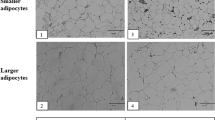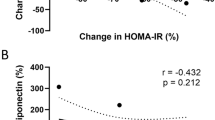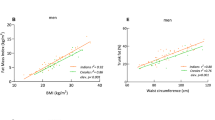Abstract
Objective
To use the combined presence of the elevated insulin resistance index in adipose tissue (Adipo-IR) and low values of adiponectin as a marker of dysfunctional adipose tissue, and to analyze its possible association with low values of high-density lipoprotein cholesterol (HDL-C) and small size of HDL particles.
Research design and methods
The analysis included 253 subjects with functional adipose tissue and 253 with dysfunctional adipose tissue, considering similar gender, age, and body mass index (BMI). Adipo-IR was considered when index values (free fatty acids × insulin concentrations) were ≥75th percentile. Low levels of adiponectin were considered when concentration in serum was <25th percentile (determined by ELISA). HDL size was estimated by a quantitative validated equation. Small HDL size was considered when values were <25th percentile.
Results
When comparing subjects with functional adipose tissue with those of dysfunctional adipose tissue, the latter had a higher prevalence of low HDL-C (51.4% vs. 64.0%; p = 0.004) and small HDL (56.9% vs. 67.6%; p = 0.009). Multivariate analysis indicated that independently from other metabolic risk factors, dysfunction of adipose tissue is significantly associated with low HDL-C (OR: 1.624 [CI 95%: 1.100–2.397]) and small HDL (OR: 1.462 [CI 95%: 1.000–2.139]). Adding BMI, waist circumference, and subcutaneous or visceral adipose tissue did not modify the association.
Conclusions
Dysfunction of adipose tissue is associated with a 65 and 50% higher probability of having low HDL-C and small HDL. Identification of dysfunctional adipose tissue could be a useful tool in the clinical setting to prevent the cardiometabolic risk independently from adiposity.
This is a preview of subscription content, access via your institution
Access options
Subscribe to this journal
Receive 12 print issues and online access
$259.00 per year
only $21.58 per issue
Buy this article
- Purchase on Springer Link
- Instant access to full article PDF
Prices may be subject to local taxes which are calculated during checkout




Similar content being viewed by others
References
Gustafson B. Adipose tissue, inflammation and atherosclerosis. J Atheroscler Thromb. 2010;17:332–41.
Krause BR, Hartman AD. Adipose tissue and cholesterol metabolism. J Lipid Res. 1984;25:97–110.
Hammarstedt A, Gogg S, Hedjazifar S, Nerstedt A, Smith U. Impaired adipogenesis and dysfunctional adipose tissue in human hypertrophic obesity. Physiol Rev. 2018;98:1911–41.
Armani A, Berry A, Cirulli F, Caprio M. Molecular mechanisms underlying metabolic syndrome: the expanding role of the adipocyte. FASEB J. 2017;31:4240–55.
Gastaldelli A, Gaggini M, DeFronzo RA. Role of adipose tissue insulin resistance in the natural history of type 2 diabetes: results from the San Antonio Metabolism Study. Diabetes. 2017;66:815–22.
Huang JP, Hsu SC, Meir YJ, Hsieh PS, Chang CC, Chen KH, et al. Role of dysfunctional adipocytes in cholesterol-induced nonobese metabolic syndrome. J Mol Endocrinol. 2018;60:307–21.
Zhang Y, McGillicuddy FC, Hinkle CC, O’Neill S, Glick JM, Rothblat GH, et al. Adipocyte modulation of high-density lipoprotein cholesterol. Circulation. 2010;121:1347–55.
Chung S, Sawyer JK, Gebre AK, Maeda N, Parks JS. Adipose tissue ATP binding cassette transporter A1 contributes to high-density lipoprotein biogenesis in vivo. Circulation. 2011;124:1663–72.
Holland WL, Miller RA, Wang ZV, Sun K, Barth BM, Bui HH, et al. Receptor-mediated activation of ceramidase activity initiates the pleiotropic actions of adiponectin. Nat Med. 2011;17:55–63.
Gordon T, Castelli WP, Hjortland MC, Kannel WB, Dawber TR. The Framingham Study. High density lipoprotein as a protective factor against coronary heart disease. Am J Med. 1977;62:707–14.
Kelley DE, Williams KV, Price JC, McKolanis TM, Goodpaster BH, Thaete FL. Plasma fatty acids, adiposity, and variance of skeletal muscle insulin resistance in type 2 diabetes mellitus. J Clin Endocrinol Metab. 2001;86:5412–9.
Iqbal F, Baker WS, Khan MI, Thukuntla S, McKinney KH, Abate N, et al. Current and future therapies for addressing the effects of inflammation on HDL cholesterol metabolism. Br J Pharmacol. 2017;174:3986–4006.
Pérez-Méndez O, Torres-Tamayo M, Posadas-Romero C, Vidaure Garcés V, Carreón-Torres E, Mendoza-Pérez E, et al. Abnormal HDL subclasses distribution in overweight children with insulin resistance or type 2 diabetes mellitus. Clin Chim Acta. 2007;376:17–22.
Hansel B, Giral P, Nobecourt E, Chantepie S, Bruckert E, Chapman MJ, et al. Metabolic syndrome is associated with elevated oxidative stress and dysfunctional dense high-density lipoprotein particles displaying impaired antioxidative activity. J Clin Endocrinol Metab. 2004;89:4963–71.
Medina-Urrutia A, Juárez-Rojas JG, Cardoso-Saldaña G, Jorge-Galarza E, Posadas-Sánchez R, Martínez-Alvarado R, et al. Abnormal high-density lipoproteins in overweight adolescents with atherogenic dyslipidemia. Pediatrics. 2011;127:e1521–1527.
Medina-Urrutia A, Juárez-Rojas JG, Martínez-Alvarado R, Jorge-Galarza E, Posadas-Sánchez R, Caracas-Portilla N, et al. High-density lipoprotein subclasses distribution and composition in Mexican adolescents with low HDL cholesterol and/or high triglyceride concentrations, and its association with insulin and C-reactive protein. Atherosclerosis. 2008;201:392–7.
Twig G, Afek A, Derazne E, Tzur D, Cukierman-Yaffe T, Gerstein HC, et al. Diabetes risk among overweight and obese metabolically healthy young adults. Diabetes Care. 2014;37:2989–95.
Phillips CM, Perry IJ. Does inflammation determine metabolic health status in obese and nonobese adults? J Clin Endocrinol Metab. 2013;98:E1610–E1619.
Hammarstedt A, Graham TE, Kahn BB. Adipose tissue dysregulation and reduced insulin sensitivity in non-obese individuals with enlarged abdominal adipose cells. Diabetol Metab Syndr. 2012;4:42.
Henninger AM, Eliasson B, Jenndahl LE, Hammarstedt A. Adipocyte hypertrophy, inflammation and fibrosis characterize subcutaneous adipose tissue of healthy, non- obese subjects predisposed to type 2 diabetes. PLoS ONE. 2014;9:e105262.
Lotta LA, Gulati P, Day FR, Payne F, Ongen H, van de Bunt M, et al. Integrative genomic analysis implicates limited peripheral adipose storage capacity in the pathogenesis of human insulin resistance. Nat Genet. 2017;49:17–26.
Scott RA, Fall T, Pasko D, Barker A, Sharp SJ, Arriola L, et al. Common genetic variants highlight the role of insulin resistance and body fat distribution in type 2 diabetes, independent of obesity. Diabetes. 2014;63:4378–87.
St-Onge MP, Janssen I, Heymsfield SB. Metabolic syndrome in normal-weight Americans: new definition of the metabolically obese, normal-weight individual. Diabetes Care. 2004;27:2222–8.
Gastaldelli A, Miyazaki Y, Mahankali A, Berria R, Pettiti M, Buzzigoli E, et al. The effect of pioglitazone on the liver: role of adiponectin. Diabetes Care. 2006;29:2275–81.
Bajaj M, Suraamornkul S, Piper P, Hardies LJ, Glass L, Cersosimo E, et al. Decreased plasma adiponectin concentrations are closely related to hepatic fat content and hepatic insulin resistance in pioglitazone-treated type 2 diabetic patients. J Clin Endocrinol Metab. 2004;89:200–6.
Kim JY, Bacha F, Tfayli H, Michaliszyn SF, Yousuf S, Arslanian S. Adipose tissue insulin resistance in youth on the spectrum from normal weight to obese and from normal glucose tolerance to impaired glucose tolerance to type 2 diabetes. Diabetes Care. 2019;42:265–72.
Zhan C, Shi M, Yang Y, Pang H, Fei S, Bai L, et al. Prevalence and risk factors of carotid plaque among middle-aged and elderly adults in rural Tianjin, China. Sci Rep. 2016;6:23870.
Baecke JA, Burema J, Frijters JE. A short questionnaire for the measurement of habitual physical activity in epidemiological studies. Am J Clin Nutr. 1982;36:936–42.
Sánchez-Castillo CP, Velázquez-Monroy O, Berber A, Lara-Esqueda A, Tapia-Conyer R, James WP. Anthropometric cutoff points for predicting chronic diseases in the Mexican National Health Survey 2000. Obes Res. 2003;11:442–51.
DeLong DM, DeLong ER, Wood PD, Lippel K, Rifkind BM. A comparison of methods for the estimation of plasma low- and very low-density lipoprotein cholesterol. The Lipid Research Clinics Prevalence Study. JAMA. 1986;256:2372–7.
Mazer NA, Giulianini F, Paynter NP, Jordan P, Mora S. A comparison of the theoretical relationship between HDL size and the ratio of HDL cholesterol to apolipoprotein A-I with experimental results from the Women’s Health Study. Clin Chem. 2013;59:949–58.
Medina-Urrutia A, Posadas-Romero C, Jorge-Galarza E, López-Uribe AR, González-Salazar MC, Juárez-Rojas JG. Inflammasome activation markers are independently associated with hypoalphalipoproteinemia in a Mexican-Mestizo population. Clin Investig. 2018;8:113–21.
Maurovich-Horvat P, Massaro J, Fox CS, Moselewski F, O’Donnell CJ, Hoffmann U. Comparison of anthropometric, area- and volume-based assessment of abdominal subcutaneous and visceral adipose tissue volumes using multi-detector computed tomography. Int J Obes. 2007;31:500–6.
Kvist H, Chowdhury B, Grangård U, Tylén U, Sjöström L. Total and visceral adipose-tissue volumes derived from measurements with computed tomography in adult men and women: predictive equations. Am J Clin Nutr. 1988;48:1351–61.
Yang RZ, Lee MJ, Hu H, Pollin TI, Ryan AS, Nicklas BJ, et al. Acute-phase serum amyloid A: an inflammatory adipokine and potential link between obesity and its metabolic complications. Plos Med. 2006;3:e287.
Khan UI, Ogorodnikova AD, Xu L, Wang D, Wassertheil-Smoller S, Ho GY, et al. The adipokine profile of metabolically benign obese and at-risk normal weight postmenopausal women: the Women’s Health Initiative Observational Study. Obesity. 2014;22:786–94.
Gray SL, Vidal-Puig AJ. Adipose tissue expandability in the maintenance of metabolic homeostasis. Nutr Rev. 2007;65:S7–S12.
Després JP, Lemieux I, Bergeron J, Pibarot P, Mathieu P, Larose E, et al. Abdominal obesity and the metabolic syndrome: contribution to global cardiometabolic risk. Arterioscler Thromb Vasc Biol. 2008;28:1039–49.
Miyazaki Y, Glass L, Triplitt C, Matsuda M, Cusi K, Mahankali A, et al. Effect of rosiglitazone on glucose and non-esterified fatty acid metabolism in type II diabetic patients. Diabetologia. 2001;44:2210–9.
Rader DJ, Hovingh GK. HDL and cardiovascular disease. Lancet. 2014;384:618–25.
Mora S. Advanced lipoprotein testing and subfractionation are not (yet) ready for routine clinical use. Circulation. 2009;119:2396–404.
Sondergaard E, Espinosa De Ycaza AE, Morgan-Bathke M, Jensen MD. How to measure adipose tissue insulin sensitivity. J Clin Endocrinol Metab. 2017;102:1193–9.
Acknowledgements
This study was partially supported by Mexico´s Consejo Nacional de Ciencia y Tecnología (Project no. SALUD-2010-2-150537) and Instituto Nacional de Cardiología Ignacio Chávez (Project no. 17-1040).
Author information
Authors and Affiliations
Contributions
JGJR conceived the project, researched data, contributed to discussion, and wrote the manuscript. ITV provided critical review and revision, and contributed to discussion. AXMU, JRB, VHSE, CPR, and AMC researched data and contributed to discussion. CPR and EJG conceived the project, contributed to discussion, and provided critical review and revision. JGJR is the guarantor of this work and, as such, had full access to all the data in the study and takes responsibility for the integrity of the data and the accuracy of the data analysis.
Corresponding author
Ethics declarations
Conflict of interest
The authors declare they have no conflict of interest.
Additional information
Publisher’s note Springer Nature remains neutral with regard to jurisdictional claims in published maps and institutional affiliations.
Rights and permissions
About this article
Cite this article
Juárez-Rojas, J.G., Torre-Villalvazo, I., Medina-Urrutia, A.X. et al. Participation of white adipose tissue dysfunction on circulating HDL cholesterol and HDL particle size in apparently healthy humans. Int J Obes 44, 920–928 (2020). https://doi.org/10.1038/s41366-019-0493-y
Received:
Revised:
Accepted:
Published:
Issue Date:
DOI: https://doi.org/10.1038/s41366-019-0493-y
This article is cited by
-
Adipose tissue dysfunction serum markers are associated with high density lipoprotein size and glycation in the early stages of type 2 diabetes
Lipids in Health and Disease (2023)
-
Weight loss normalizes enhanced expression of the oncogene survivin in visceral adipose tissue and blood leukocytes from individuals with obesity
International Journal of Obesity (2021)



